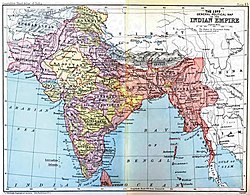Portuguese State of India
| State of India | ||||||||||||||
| Estado da Índia | ||||||||||||||
|
Colony; Overseas Province State of the Portuguese Empire |
||||||||||||||
|
||||||||||||||
|
||||||||||||||
|
Anthem "Hymno Patriótico" (1808–26) Patriotic Anthem "Hino da Carta" (1826–1911) Hymn of the Charter "A Portuguesa" (1911–61) The Portuguese |
||||||||||||||
|
Portuguese India evolution. The State of India (Estado da Índia) in the 16th and 17th centuries also included possessions in all the Asian Subcontinents, East Africa, and in the Pacific
|
||||||||||||||
| Capital | Nova Goa (Cochin to 1530) | |||||||||||||
| Languages |
Portuguese
Also spoken; Konkani, Kannada, Gujarati, Marathi, Malayalam, others |
|||||||||||||
| Political structure |
Colony; Overseas Province State of the Portuguese Empire |
|||||||||||||
| Head of state | ||||||||||||||
| • |
King 1511–21 |
Manuel I of Portugal | ||||||||||||
| • |
President 1958–61 |
Américo Tomás | ||||||||||||
| Viceroy | ||||||||||||||
| • | 1505–9 | Francisco de Almeida (first) | ||||||||||||
| • | 1896 | Afonso, Duke of Porto (last) | ||||||||||||
| Governor-general | ||||||||||||||
| • | 1509–15 | Afonso de Albuquerque (first) | ||||||||||||
| • | 1958–61 | Manuel António Vassalo e Silva (last) | ||||||||||||
| Historical era | Imperialism | |||||||||||||
| • | Fall of Sultanate of Bijapur | 15 August 1505 | ||||||||||||
| • | Indian Annexation; | 19 December 1961 | ||||||||||||
| Currency |
Portuguese Indian rupia (INPR) Portuguese Indian escudo (INPES) |
|||||||||||||
|
||||||||||||||
| Today part of |
|
|||||||||||||

Imperial entities of India
|
|
| Dutch India | 1605–1825 |
|---|---|
| Danish India | 1620–1869 |
| French India | 1668–1954 |
|
|
|
| Casa da Índia | 1434–1833 |
| Portuguese East India Company | 1628–1633 |
|
|
|
| East India Company | 1612–1757 |
| Company rule in India | 1757–1858 |
| British Raj | 1858–1947 |
| British rule in Burma | 1824–1948 |
| Princely states | 1721–1949 |
| Partition of India |
1947
|
|
|
|
Also spoken; Konkani, Kannada, Gujarati, Marathi, Malayalam, others
The State of India (Portuguese: Estado da Índia), also referred as the Portuguese State of India (Estado Português da Índia, EPI) or simply Portuguese India (Índia Portuguesa), was a state of the Portuguese Overseas Empire, founded six years after the discovery of a sea route between Portugal and the Indian Subcontinent to serve as the governing body of a string of Portuguese fortresses and colonies overseas.
The first viceroy, Francisco de Almeida, established his headquarters in Cochin (Cochim, Kochi). Subsequent Portuguese governors were not always of viceroy rank. After 1510, the capital of the Portuguese viceroyalty was transferred to Goa. Until the 18th century, the Portuguese governor in Goa had authority over all Portuguese possessions in the Indian Ocean, from southern Africa to southeast Asia. In 1752 Mozambique got its own separate government and in 1844 the Portuguese Government of India stopped administering the territory of Macau, Solor and Timor, and its authority was confined to the colonial holdings on the Malabar coast of present-day India.
At the time of the British Indian Empire's dissolution in 1947, Portuguese India was subdivided into three districts located on modern-day India's western coast, sometimes referred to collectively as Goa: These were Goa; Daman (Portuguese: Damão), which included the inland enclaves of Dadra and Nagar Haveli; and Diu. Portugal lost effective control of the enclaves of Dadra and Nagar Haveli in 1954, and finally the rest of the overseas territory in December 1961, when it was taken by India after military action. In spite of this, Portugal only recognised Indian control in 1975, after the Carnation Revolution and the fall of the Estado Novo regime.
...
Wikipedia




